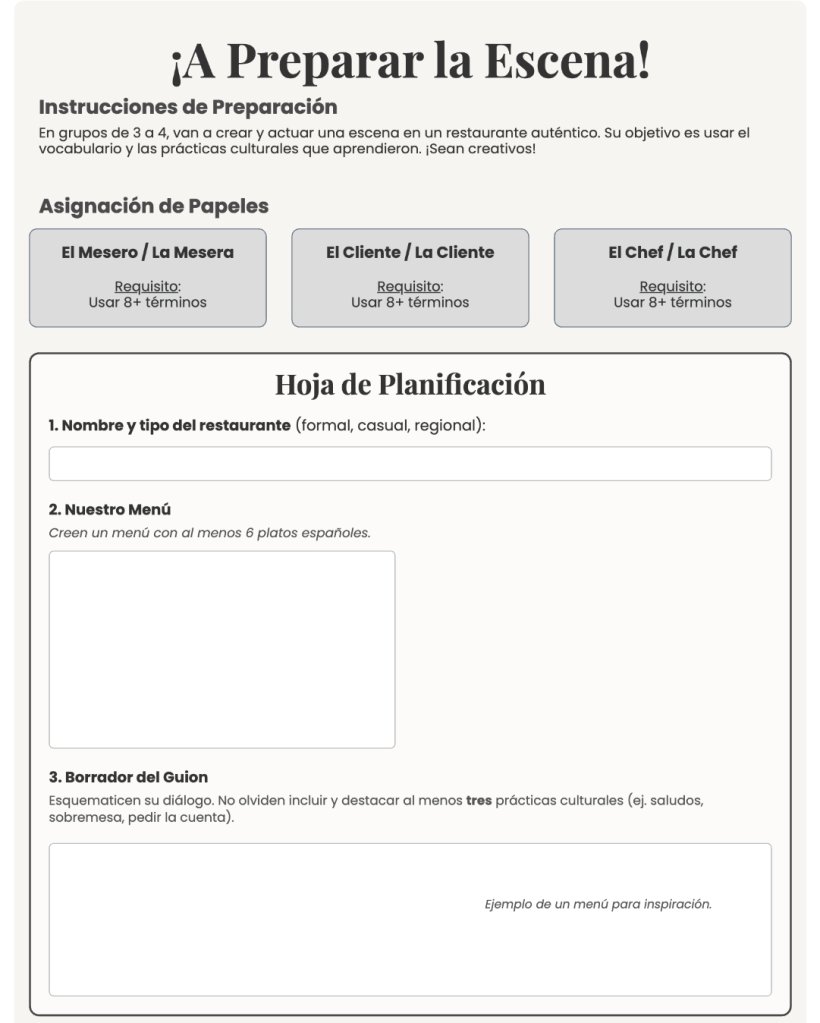8 Creative Performance Tasks for World Language Classes
Try these ideas to move from vocabulary quizzes to activities where students communicate in real-world situations.
Your content has been saved!
Go to My Saved Content.As a longtime world language educator, I have used many traditional assessments in my own classroom. For years, I was teaching my own students the way that I had been taught. I used the same structure, strategies, and even assessments that my own language teachers used with me years ago. Since their instructional practices worked for me, I used them as a guide for my own practice.
Although these methods helped me, as a teacher, better understand where my students were in their learning journey, they failed to capture and assess what truly matters: a learner’s ability to communicate authentically in the target language. Performance tasks change everything. When students have more choice in the product, they can demonstrate their knowledge in authentic and meaningful ways, which amplifies knowledge retention and boosts confidence in communicating.
Benefits of Creative Performance Tasks
Traditional assessments often reward memorization of content rather than focusing on the development and mastery of communication skills. They are low-level tasks that do not significantly extend students’ learning. For example, a fill-in-the-blanks exercise on verb conjugations may show that a student understands how to form verbs and remembers the verb endings, but it doesn’t indicate whether students can use the verbs and vocabulary in a real conversation. These activities do not require a true application of the language throughout different contexts or scenarios.
Performance tasks place students in real-world scenarios that mirror authentic communication, better preparing them for meaningful conversations and the application of their language skills. They promote differentiation through student choice, helping to build skills in critical thinking, problem-solving, and creativity.
When we provide students with more autonomy in demonstrating their knowledge and skills, they experience a greater sense of ownership and confidence in their learning. They may then push themselves to achieve higher levels of proficiency.
I ask myself: How can I give my students the chance to perform, create, and connect?
It takes time to create performance tasks, and over the years, I have leveraged different AI-powered tools to brainstorm new ideas, focus on differentiation, and help me think through a unit plan for my students. I’ve been exploring Learning Genie to generate lessons and new ideas, offer assessments, and provide culturally and linguistically responsive practices, as well as standards, among other resources for educators.
For example, I created an entire curriculum that included four lessons for a restaurant theme. Learning Genie created a Restaurant Mystery Menu Challenge, an activity that included a sketch and a tell. It also created a Frayer activity related to cultural dining customs, as well as more authentic and engaging activities.
8 Performance Tasks to Try
1. Debates. For upper-level students, structured debates or speeches on cultural or contemporary issues help them practice formal language use and build critical thinking skills. Using tools like MagicSchool AI and SchoolAI, they can even practice with a famous historical character or chatbot to build confidence before a live debate. Students can speak through voice or text in the target language with a character or chatbot; it only needs the teacher to include the specific requirement in the prompt. I will include in my prompt the fact that students are required to speak only in Spanish and that they need to stay on the topic of the chat. It has been a great learning experience for them and a way to build their confidence in speaking the language.
2. Digital storytelling. The benefits of digital storytelling include encouraging creativity, integrating speaking and writing skills, and helping students develop fluency and confidence in sharing personal experiences or exploring cultural themes. I prompt students to draft a short story or think about a cultural folktale and then work to retell it in the target language. Students record a narration and add visuals, such as photos, drawings, or video shorts, using tools like Book Creator, Canva, or WeVideo. I like to share student work and often use Padlet or Wakelet so that students can participate in a virtual gallery walk and provide feedback to their classmates.
3. Jobs and career explorations. Students can also explore careers that interest them and investigate how those professions connect to countries or communities where the target language is spoken. They can then collaborate with a partner to engage in a mock interview in the target language. My students in Spanish IV create résumés and digital portfolios and take turns interviewing each other in class. It not only was highly beneficial for their language skills, but also helped them understand how knowing another language benefits professionals in various fields of work.
4. Podcasting and vlogs. Students can script and record conversations, interviews, or cultural commentaries, which highlight both listening and speaking skills. My students choose themes such as a restaurant, a cooking show, a travel agency, and interviews with famous historical figures. Students can also record short podcasts or vlogs in which they interview classmates, teachers, or family members (real or fictional) about their daily lives, traditions, or even opinions on a topic. Some students have used tools such as Spotify or WeVideo.
5. Posters and visual projects. Students design posters or infographics to advertise a product, educate others about a cultural holiday, or make comparisons and provide key facts about a country or community where the target language is spoken. Students apply vocabulary, grammar, and cultural knowledge in meaningful ways. They can then participate in a gallery walk, view each other’s work, and participate in Q&A sessions in the target language.

6. Role-plays and skits. Students act out real-life scenarios, such as ordering at a restaurant, making travel plans, shopping, or seeking medical assistance. These tasks encourage spontaneous speaking and teamwork. TeachShare creates planning sheets to share with students so they can assign roles and build their plan, all in the target language. The planning sheet includes instructions and assigned roles in the target language.
7. Storytelling circles. Using vocabulary from a unit, students take turns adding lines to a collective story. This builds listening comprehension and encourages students to be creative and have fun learning. Students can even collaborate on writing a book using Book Creator and record themselves narrating the story in the target language. My students used Delightex to collaborate on a story brought to life through augmented and virtual reality. Students retained the content even more by immersing in a virtual world they created.
8. Travel itinerary. Students plan a three-day trip to a city or region in a target-language country, writing an itinerary that includes lodging, meals, and activities. They present the itinerary using tools like Canva or Genially and can even use Snorkl to discuss the itinerary in the target language and receive immediate AI-powered and teacher feedback.
For language educators, helping students communicate meaningfully and connect across cultures is essential. Performance tasks like these make this possible by redefining assessment as authentic expression and collaboration, enabling students to create, perform, and engage in real-world tasks. Students will become more confident and curious about language and connections, and hopefully they’ll discover the joy and purpose of language learning.
